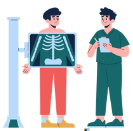Loading...

Diagnostic Radiography vs. Medical Imaging Technology: A Course Comparison
When it comes to careers in the medical field, there’s a multitude of paths to explore. Among the array of rewarding options, two prominent choices are Diagnostic Radiography and Medical Imaging Technology. Both fields use advanced imaging techniques to diagnose and treat various medical conditions. However, there’s a key difference between the two: the level of education required.
This blog will delve into the distinct features of Diagnostic Radiography and Medical Imaging Technology degrees.
If you’ve ever wondered about the discrepancies between these courses or dreamt of a career in the fascinating world of medical imaging, read on!
Diagnostic Radiography
Diagnostic Radiography is a specialised field within medical imaging that focuses on capturing detailed images of the internal structures of the human body. These images play a crucial role in aiding healthcare professionals in diagnosing various medical conditions accurately. As an undergraduate course (BSc), Diagnostic Radiography equips students with essential skills in operating imaging equipment, positioning patients for precise imaging, and ensuring patient safety.
Students pursuing Diagnostic Radiography undergo a comprehensive curriculum that includes courses in anatomy, physiology, medical imaging techniques, radiation safety, and patient care. Additionally, they benefit from hands-on clinical training, gaining practical experience in real healthcare settings.
Upon graduation, diagnostic radiographers are well-prepared to enter the workforce and contribute to patient care in hospitals, clinics, and imaging centres.
Medical Imaging Technology
Medical Imaging Technology, offered as a Master’s (MSc) programme, is an advanced and specialised route within medical imaging. This postgraduate programme delves deeper into cutting-edge technologies, research, and advanced imaging techniques. To pursue an MSc in Medical Imaging Technology, candidates must typically have a bachelor’s degree in a related field.
The MSc programme equips students with specialised knowledge and expertise in imaging modalities, such as Magnetic Resonance Imaging (MRI), Computed Tomography (CT), and ultrasound. Graduates of this programme are positioned to take on leadership roles, delve into innovative research, and contribute to advancements in the field of medical imaging.
The specialised skills acquired through the MSc programme open doors to unique career opportunities and allow graduates to play an instrumental role in driving technological advancements in healthcare.
BSc or MSc?
Deciding between pursuing a BSc in Diagnostic Radiography or an MSc in Medical Imaging Technology is a significant decision that can shape your career trajectory in medical imaging. Each option offers distinct advantages and opportunities, and the choice should align with your individual preferences, career goals, and academic aspirations.
BSc in Diagnostic Radiography:
1. Faster Entry into the Workforce:
Opting for a BSc allows you to enter the workforce sooner than pursuing a postgraduate degree. This can be particularly appealing if you are eager to start your career and gain practical experience soon.
2. Lower Educational Costs:
Pursuing an undergraduate degree typically incurs lower educational costs compared to postgraduate programs. This can be advantageous to avoid significant student debt or financial commitments.
3. Diverse Employment Opportunities:
With a BSc in Diagnostic Radiography, you can find employment in various healthcare settings, including hospitals, clinics, and imaging centres. The degree’s versatility offers opportunities to explore different roles within the field.
4. Hands-on Experience:
BSc programmes often incorporate extensive clinical training and practical experience, enabling you to apply your knowledge in real-world settings during your studies. This exposure can provide a solid foundation for your career as a diagnostic radiographer.
MSc in Medical Imaging Technology:
1. Leadership and Research Opportunities:
The MSc route opens doors to leadership positions and research opportunities in medical imaging. As an MSc graduate, you can take on roles that involve managing teams, implementing new technologies, and conducting innovative research.
2. Academic Pursuits:
If you are passionate about research and contributing to the advancement of medical imaging, pursuing an MSc can be the gateway to further academic pursuits, such as a Ph.D. This path can lead to opportunities in academia and research institutions.
3. Advancements in Technology:
Medical imaging is a rapidly evolving field with constant technological advancements. With an MSc, you’ll be at the forefront of cutting-edge technologies, significantly contributing to the industry’s progress.
4. Specialised Knowledge and Skills:
An MSc programme in Medical Imaging Technology delves deeper into advanced imaging techniques and cutting-edge technologies. It equips you with specialised knowledge and skills in high demand in the medical imaging industry.
What’s the verdict?
Both Diagnostic Radiography and Medical Imaging Technology offer promising career paths in healthcare. The primary distinction lies in the academic level, with Diagnostic Radiography being an undergraduate degree (BSc) and Medical Imaging Technology being a postgraduate programme (MSc).
Whether you prefer a faster entry into the workforce with a BSc or wish to explore advanced research and specialisation through an MSc, both paths lead to fulfilling careers that positively impact patient care.
FAQs
→ 1. What are the core differences between Diagnostic Radiography and Medical Imaging Technology degrees?
Diagnostic Radiography is an undergraduate degree (BSc), while Medical Imaging Technology is a Masters degree (MSc). The former provides a Bachelor of Science upon completion, and the latter requires a previous bachelor’s degree for admission.
→ 2. Can I work in a hospital after completing a BSc in Diagnostic Radiography?
Yes, a BSc in Diagnostic Radiography equips you with the necessary skills to work in various healthcare settings, including hospitals, clinics, and imaging centres.
→ 3. Are there any specialised areas within Medical Imaging Technology?
Yes, Medical Imaging Technology offers specialised areas such as MRI (Magnetic Resonance Imaging), CT (Computed Tomography), ultrasound, nuclear medicine, and more.
→ 4. Is it possible to pursue a Ph.D. after completing an MSc in Medical Imaging Technology?
An MSc in Medical Imaging Technology can pave the way for advanced academic pursuits, including pursuing a Ph.D. in medical imaging or related fields.
→ 5. Are there opportunities for international careers in diagnostic radiography and medical imaging?
Yes, both diagnostic radiography and medical imaging technology offer excellent opportunities for international careers. Many countries have a shortage of skilled imaging professionals, making it possible for graduates to explore job prospects abroad and contribute to global healthcare initiatives.





Was this article helpful?
Still got a question? Leave a comment
Leave a comment